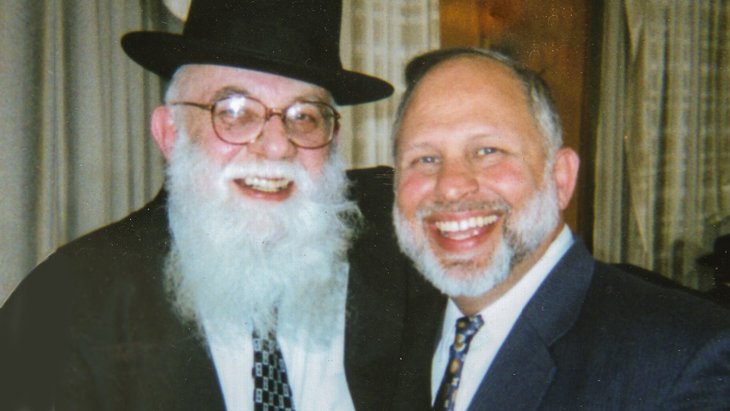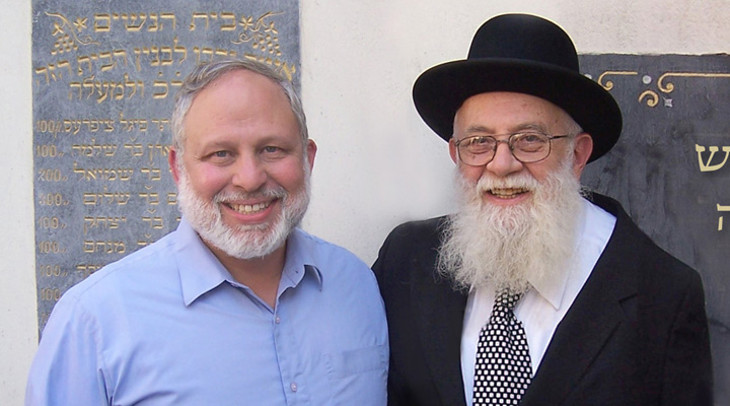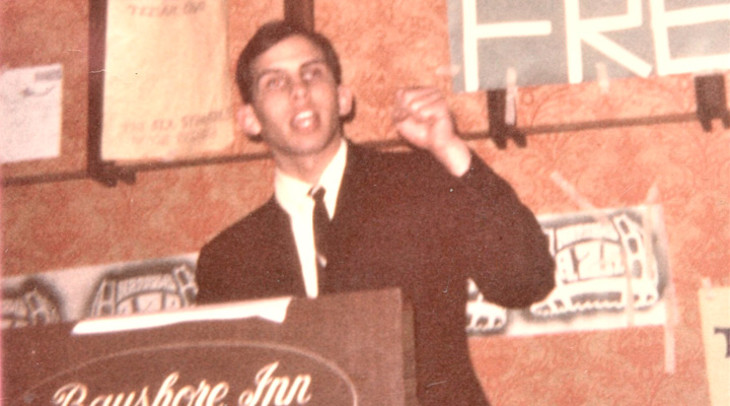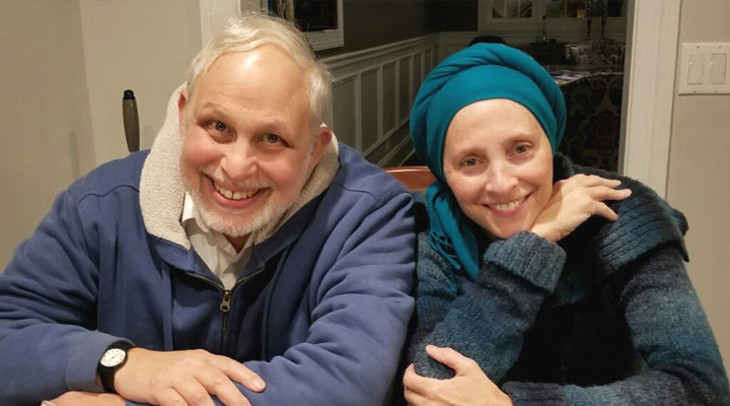 Iran’s Attack on Israel
Iran’s Attack on Israel


10 min read
Remembering one of Aish's original 6 students, and a pioneer of Jewish educational initiatives.
Imagine you’re a creative, talented and popular 22-year-old headed for law school and a bright future in tech or finance.
Now imagine you become inspired by the power of Torah and devote your life to helping the Jewish people. Over the next 45 years, you raise tens of millions of dollars to fund an array of Jewish educational programs, and pioneer the use of technology to create the iconic Shabbat Shalom Weekly and Western Wall webcam. You have a multitude of close friends and touch the lives of thousands with persistent acts of compassion and kindness. You are happily married for over 40 years and raise a loving family of nine children and numerous grandchildren, whom you call “life’s whipped cream.”
That was the life of Rabbi Kalman Packouz zt”l, 69, who passed away at his home in South Florida and was buried this week in Israel.
Kalman’s story is of a life very well lived.
Raised in Portland, Oregon, Kalman travelled around the world after graduating college, eventually landing in Israel to work on a kibbutz and go scuba diving. A friend who knew of Kalman’s interest in Judaism gave him the phone number of the great Rabbi Noah Weinberg zt”l. During a break in the kibbutz program, he traveled to Jerusalem to ask Rabbi Weinberg: “Do Jews believe in the afterlife?” Kalman was drawn to Rabbi Weinberg’s piety, wit and wisdom, and in 1974 – when Aish HaTorah was founded in the Old City of Jerusalem – he became one of its first six students.
Kalman spent long hours with Rabbi Weinberg, absorbing the depth of his teachings: life is for meaning and pleasure; the Almighty loves you; focus on kindness; be an entrepreneur for the Jewish cause.
In 1976, Kalman published the first Aish book for general distribution, How to Stop an Intermarriage, a bestseller in Jewish publishing with 6,000 copies sold. Later expanded and retitled as How to Prevent an Intermarriage, the book offers wisdom and practical advice for Jewish singles and their parents.
 Kalman with twin grandchildren.
Kalman with twin grandchildren.
In 1978, Kalman and his new bride Shoshana drove cross-country to visit his parents in Portland, Oregon. Midway, they spent Shabbat in St. Louis at the home of Kenneth Spetner, upon whom Kalman made a strong impression. Rabbi Weinberg was urged to start the first Aish branch in St. Louis, and Kalman, always eager to embark on new projects, readily accepted the challenge (together with Rabbi Chaim Willis).
With no branch model to follow and no previous experience in fundraising, Kalman succeeded in doubling the branch’s budget in the second year, igniting Jewish pride and forging a model from which all subsequent branches would learn. When asked by an interviewer in St. Louis how successful the Aish branch was, Kalman replied, “One hundred percent successful. Every Jew we have ever dealt with has a more positive feeling about Judaism than he or she did previously.”
In 1982, Kalman returned to Jerusalem to become Executive Director of Aish Jerusalem. During this time he also proudly served in the IDF.
In 1990, the Packouz family moved backed to the U.S., this time to South Florida, where Kalman ran a regional office of the Aish Jerusalem Fund. Over the years, he flew regularly to Hong Kong and other locations, raising tens of millions of dollars for an array of Jewish educational programs in Jerusalem and around the world.
 Kalman with Rabbi Noah Weinberg zt”l during a 2006 trip to Poland.
Kalman with Rabbi Noah Weinberg zt”l during a 2006 trip to Poland.
Rabbi Packouz was deeply pained by the disconnect of Jews from their precious heritage, and employed innovative technology to reverse this trend. In 1980, he gained national attention by creating the first-ever Jewish Computer Dating Service (JCDS). Appearing on the Today Show, the most popular morning show at the time, Kalman faced a hostile interviewer: “Rabbi Packouz, now is a time when America is moving away from discrimination. How do you answer those who say your Jewish dating service is based on a premise of discrimination?”
Kalman replied that the matter was not one of discrimination, but of preservation of the species. He shared this analogy: “A group in California is working to save the humpback whale. They feel if the humpback whale becomes extinct, the world and humanity will have lost something precious. Certainly the Jewish people have done more for the world and humanity than the humpback whale?”
Kalman’s second breakthrough with technology came in 1992. In this pre-Internet era, he collected fax numbers of homes and offices, then created a subscriber list for Shabbat Shalom Weekly – a newsletter featuring life lessons from the weekly Torah portion and Jewish insights into personal growth. Stamped with Kalman’s huge smile (and “thumbs-up”) the “fax of life” was warm and witty, with insightful stories, Torah lessons for life, and a pithy “quote of the week.”
What started as a local fax to 50 people, expanded globally and became the gold standard in Jewish adult education. Shabbat Shalom reached into every corner of the globe – posted on office bulletin boards, Jewish community centers, and synagogues. With the mass adoption of email in the mid-1990s, Shabbat Shalom Weekly became the first Jewish e-newsletter to reach 100,000 subscribers.
In 27 years, Kalman never missed sending the newsletter every week. The impact was enormous; to cite one example among thousands, Kalman recently received a call from a man in Israel who forwards Shabbat Shalom Weekly to a friend in England, who in turn forwards it to a woman in Russia – who subsequently became Jewishly-observant and, the caller reported, was being married that evening in Moscow to a rabbi.
Other rabbis adopted Shabbat Shalom Weekly as a tool to maintain weekly contact with donors and students. Kalman was happy that, through his efforts, others did not have to recreate the wheel.
In recent years, Kalman expanded Shabbat Shalom Weekly to three languages – English, Hebrew and Spanish. Then, at the suggestion of a colleague, he created a "Digital Eternity" project, whereby the Shabbat Shalom archives serve as a database to continue sending out a relevant weekly email in perpetuity.
During development of the early Aish website, Kalman stepped forward with another key technological innovation: “Window on the Wall,” a 24-hour webcam on the Western Wall in Jerusalem. Launched in 1997 when webcams were a novelty, the site was selected by USA Today as "Internet Site of the Day" and helped put Aish.com on the map.
On a personal level, Kalman was a paradigm of integrity. He worked on himself ceaselessly, molding and shaping his abundant natural strengths to be the best he could be.
When it came to helping others, Kalman had an extraordinary sense of justice; yet for himself humbly abided by the credo that “being kind is more important than being right.” He loved doing the right thing – at any cost – often sacrificing money and pride for the sake of peace.
Kalman had an easygoing demeanor and was a genuine "team player" who enjoyed celebrating others' success. He eschewed competitive and transactional relationships, and did not countenance “success“ devoid of the human caring element – particularly within a team working toward the same larger goal.
As a friend, Kalman was a master of loyalty, kindness, and generosity. He invested heavily in relationships, making extraordinary efforts to stay in touch with hundreds of family, friends and colleagues. He was constantly buying gifts for others. He phoned numerous people every day, and met regularly for breakfast with others.
Though Kalman was diagnosed with cancer five years ago, he kept it mostly secret until a few months ago; he did not want his illness to distract from fully-engaged relationships.
Kalman lived with the ideal that helping others does not mean "begrudgingly acceding to requests." It is rather leaving our comfort zone to proactively "chase kindness.” Like Abraham sitting at the entrance to the tent looking for guests, Kalman would go out of his way to help anyone he saw. He had bottles of water near the front door to give to delivery people. He would make the rounds at hospitals and the local prison, visiting those who are often ignored.
Kalman loved people unconditionally. He made everyone feel important and cared for, spreading love and joy wherever he went. Every interaction was punctuated with his earnest, “What do you need? How can I help?”
He was always ready with a good story or joke, because he loved making people feel good. He would send hand-written thank you notes, and would sign emails: "Much love, beloved friend. You are a blessing in my life!"
 As president of the BBYO youth group, Kalman speaks at a regional conference (circa 1968).
As president of the BBYO youth group, Kalman speaks at a regional conference (circa 1968).
Kalman helped other people raise money for their own projects and gave generously himself. Over the course of one year, Kalman wrote 800 checks to charity. In the daily Sun Sentinel, he described his view of Tikun Olam, repairing the world, as “a basic human responsibility to reach out to others. Giving of your time and your money is a statement that says, ‘I will do whatever I can to help’."
Kalman always sought to ease others’ pain. Since 1992, he maintained a “Refuah” email list, sent to thousands of people, with requests for prayers on behalf of the sick. At his home in Florida, Kalman frequently hosted a blind, paraplegic man for Shabbat and holidays, volunteering as his private nurse. When he became aware of a stranger whose husband was in emergency surgery, he spent the next hour comforting her.
In 2000, Kalman heard about the plight of an 10-year-old Israeli girl, Lisa Ostrovsky, who needed a double-lung transplant at a cost of one million dollars. Harnessing the reach of his Shabbat Shalom Weekly, Kalman alerted subscribers all over the world; the money, in denominations large and small, was raised. One man, a non-Jew named Ron Johnson read about Lisa and became the voluntarily lung donor. In Johnson's honor, Kalman arranged for planting a grove of trees in Israel.
Kalman was fiercely loyal to his rabbi, Rabbi Noah Weinberg. After Rabbi Weinberg’s passing in 2009, Kalman collected the hundreds of letters of gratitude from former students and, along with photos and eulogies, prepared a 400-page volume entitled “Remembering Rabbi Noah Weinberg,” which he presented as a gift to the Weinberg family.
Kalman worked diligently on his connection with God, living with constant awareness of: “What does the Almighty want from me right now?” He was a role model for saying prayers and blessings with mindfulness. In his final hours, barely conscious, he often repeated the words Ain ode mil'vado – “there is none besides God.”
Kalman was totally devoted to his family, constantly encouraging his children and grandchildren to pursue their dreams. He had enormous respect and appreciation for his wife, Shoshana, and dedicated this week’s posthumous Shabbat Shalom Weekly to her, saying that “All that I have accomplished I owe to her.” (With wry humor, Kalman also dedicated this week’s Shabbat Shalom to his own memory.)
 Kalman and his beloved wife, Shoshana.
Kalman and his beloved wife, Shoshana.
A great light has been extinguished. Rabbi Kalman Packouz was a true mensch whose positive attitude and warm heart inspired thousands. In a parting message, he said: “If you want happiness and joy in life, never miss the opportunity to do a kindness, or express gratitude.”
Every day, find a kindness or express gratitude, in the merit of:
HaRav Kalman Moshe ben Reuven Avigdor zt”l
הרב קלמן משה בן ראובן אביגדור זצ״ל
You can send a message to the Packouz family in the comments box below.
Thanks to Jonathan Rosenblum for sharing research.

My name is Ron Johnson, and Rabbi Packouz was my friend. In 2000 I donated a lung lobe for Lisa Ostrovsky, and the Rabbi arranged a grove of trees for me. One day I hope to see that grove, but I'm 72 now and only have a pension to live on. Please send my best wishes to Kalman's family, and tell them I will never forget his wisdom and the kindness he showed to me.